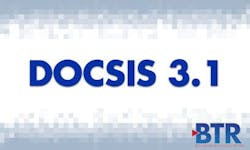Following up on statements made at Cable-Tec Expo earlier this month in Denver, CableLabs announced last week that registration was open for the first DOCSIS 3.1 Interop. It's a short turnaround: The event is to be held during the first week of December at the consortium's headquarters in Louisville, CO.
That isn't the only sign that operators are getting closer to being able to really consider their DOCSIS 3.1 purchases. A number of vendors recently have made announcements that suggest the standard - that goes a long way toward neutralizing the telephone industry's fiber-only or fiber-rich approaches - is getting closer to a reality.
The drive to make DOCSIS 3.1 real is illustrated by the increasing frequency of announcements. In the past month, a number of new products were unveiled. Of course, Cable-Tec Expo was held in late September, so this might not be the most representative month. In any case, vendors clearly see the opportunity and are delivering.
One of the most interesting announcements is from Peregine Semiconductor. The company is offering customer premises equipment (CPE) makers technology that it says will greatly ease a real world challenge of running systems that simultaneously use DOCSIS 3.1 and earlier revs of the spec.
While it is true that all iterations of DOCSIS are designed to be backward compatible to earlier versions, DOCSIS 3.1 offers a unique challenge: The optimal implementation of the technology at some point involves moving or expanding the upstream path. That creates the obvious problem of having devices with different upstreams in the same network.
Thus, while the specs are compatible, channel mapping issues may present problems. Kinana Hussain, Peregrine's senior manager for worldwide marketing, said the company's UltraCMOS PE42722 switch enables mixed environments of legacy (5-42 MHz), mid-split (5-84 MHz) and high-split upstream operation.
The introduction of a switch into the data stream is not a trivial matter, Hussain said. It is possible to create tiny distortions that are magnified as the upstream signals are amplified. The PE42722, Hussain said, offers high linearity that reduces the chances for such distortions to occur.
The ability to choose upstream channels by individually programing gateways, STBs and modems can save operators capex and reduce the variety of premises devices that have to be stocked.
Other announcements that, one way or another, are aimed at readying cable networks for DOCSIS 3.1 have recently been made, particularly at the chip and other component level. Some examples:
- MaxLinear introduced the MxL235 upstream programmable gain amplifier. The company said it can transmit any combination of DOCSIS 3.0 and 3.1 channels to a combined output power of 69 dBmV. It is a companion device to the company's DOCSIS 3.1 FSC receivers, which had not yet been released.
- Emcore introduced the 7840 DOCSIS 3.1 Low Noise CATV Optical Receiver, which supports optical bandwidths to 1.2 GHz. The company also unveiled the Medallion 2100 Optical A/B switch, which it says is a high performance platform that provides network protection and optical redundancy in cable and fiber networks.
- Anadigics last month introduced a reverse path amplifier that is aimed at the DOCSIS 3.1 sector. The ARA2032 is designed to offer high linearity, output power and noise performance over the 5 MHz to 300 MHz band, including the upstream.
- Another sign that DOCSIS 3.1 is becoming a true top-of-agenda item at the operational level is training. Excentis announced last month that training will be offered in Atlanta on Nov. 13 and 14 and in Santa Clara, CA, on Nov. 18 and 19. The company already has offered DOCSIS 3.1 training in Europe.
- RFMD used Cable-Tec Expo to introduce six gallium nitride (GaN) devices aimed at enabling DOCSIS 3.1 operations. The company said that family includes 1.2 GHz power doubling amplifiers, push/pull amplifiers, optical receivers, a reverse path amplifier and digital step attenuators. RFMD says it has 25 products aimed at meeting DOCSIS 3.1 specs.
- Averna also used the conference to unveil a product. The DOCSIS DP-1000 Protocol Analyzer, according to the company, is designed for both DOCSIS 3.0 and 3.1. It is designed to analyze, debug, maintain and monitor local networks and Internet connections, according to the company. It is aimed at operators, chipset manufacturers, product developers and certification organizations.
The three surest signs that a major new innovation is closing in on being available are interops, training and compliant components. All three have been in evidence during the past couple of months.
About the Author

